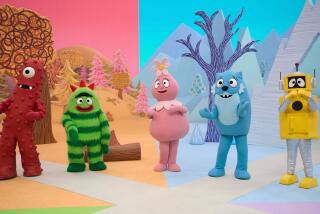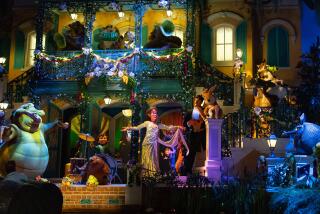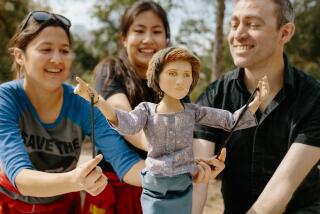‘The Sprites’ thrives in Broadway’s ecosystem
New York — THERE was one more day of shooting left before the new Disney Channel show “Johnny and the Sprites” wrapped production, and Michael Schupbach was touching up a pile of puppets sprawled out on a table in a corner of the set.
A little-known fact about puppets: They get pretty worn out.
“It’s essentially a very complicated piece of cloth,” said Schupbach, the show’s puppet designer and co-art director. “So if you can imagine wearing a sweater every day, eventually you’ve got to start cleaning it and sewing up holes.”
With 24 unique characters and an extended collection of small hand puppets called Fuzzies, the cast of “Johnny and the Sprites” kept the crew busy. Along with Basil, Ginger, Lily and Root -- fairy-like creatures that live in a magical forest called Grotto’s Grove -- there were minor players like a yellow snail with swiveling eyeballs and a small acorn that could skitter across a tree branch.
“We really want to give the feeling of an ecosystem,” Schupbach said.
Walking onto the set of the show -- which premieres as part of the Playhouse Disney programming block at 10 a.m. on Jan. 13 -- felt like entering a fully realized world. On a soundstage at Kaufman Astoria Studios, a lush forest adorned with twinkling lights and huge flowers soared up to the ceiling. Tucked in the middle of the greenery sat a cozy wooden house with brightly lighted stained glass windows. Heavy ivy vines snaked around the porch and into the trees -- so large and elaborate that it took a construction shop that specializes in building opera sets to pull them off.
The house is the domain of Johnny T., a singer-songwriter played by Broadway star John Tartaglia, who created the show. The premise: Johnny inherits his uncle’s home in the forest, where he discovers a tunnel in his backyard that leads to Grotto’s Grove.
There, he meets the Sprites, winsome creatures that represent different aspects of nature. Together, they embark on adventures aimed at teaching preschoolers about accepting each other’s differences.
The program, which first aired as a short-form series in 2005, takes the current popularity of incorporating music into children’s programming to another level. Tartaglia, who received a Tony nomination for his work in “Avenue Q,” recruited a slew of top Broadway talent to compose a collection of catchy tunes for the show.
Composer and lyricist Stephen Schwartz of “Wicked” wrote the theme song, among other pieces. Gary Adler of “Avenue Q” is the music director, and additional songs were composed by the likes of Mark Hollmann (“Urinetown”) and Michael Patrick Walker (“Altar Boyz”).
“When you’re working in the Broadway community, it really is like a little family, so everyone kind of knows each other and supports each other,” said Tartaglia, 28, who is also playing Lumiere in the Broadway production of “Beauty and the Beast.”
That tight-knit feeling extended to the cast members, who compared working on the show to being at summer camp. Many knew each other from “Sesame Street,” where Tartaglia got his start, and other children’s shows.
“My favorite thing about this group is that we’re all really 5,” said Tim Lagasse, the puppeteer behind Basil, the bookish Earth Sprite. “We all get on the set and put the puppets on and act like little idiots and giggle all day.”
Tartaglia has loved puppets since he was a kid growing up in Maple Shade, N.J., the son of a musical director and an actress.
“You can make a puppet truly seem alive, and there are very few things you can do that with,” he said.
“I’ve watched the most jaded, cynical adults -- you put a puppet in front of them and they just come alive. It’s powerful, really powerful.”
Around age 8, he announced to his mother that he was going to move to New York when he was 18 and work on “Sesame Street.” In fact, he began working on the public television show part time when he was 16 as the backup puppeteer for Elmo. He got hired full time after he graduated from high school, staying on 11 years.
Tartaglia dreamed of creating his own children’s show. “But I thought it would be something I did when I was in my 50s and had won the lottery,” he said.
Instead, he was performing in “Avenue Q” several years ago when he got a note from Rich Ross, president of Disney Channel Worldwide, who had seen the show and wanted to meet with him.
“He said, ‘I really loved your energy and I want you to create a show for me,’ ” Tartaglia recalled. “It literally was that golden opportunity that comes once in a million years.”
The idea for the Sprites had come to Tartaglia when he was 16, he said, sketched out on a notebook while he was hanging out at one of his father’s rehearsals. He and the show’s four other co-creators met regularly at a Starbucks to flesh out the idea.
“We worked to figure out who these characters were as people first before we did any kind of drawing,” Schupbach said. “We really made sure we knew who Ginger was and what she had for breakfast that day, and then based our design on that.”
The set was also laid out to accommodate both people and puppets, with holes cut into countertops inside Johnny’s house and raised scenery in the forest so the puppeteers could do their work standing up.
Still, the long days of holding the Sprites over their heads took a toll.
“I’ve experienced those cramps where sometimes you send the information to the hand -- Open! Close! -- and it’s not moving,” said Carmen Osbahr, who plays Lily, the dramatic Water Sprite.
Added Lagasse: “When puppeteers aren’t talking about puppetry, they’re talking about how much they’re in pain: ‘Oh man, my hand.’ If it were easy, everyone would be doing it.”
More to Read
The biggest entertainment stories
Get our big stories about Hollywood, film, television, music, arts, culture and more right in your inbox as soon as they publish.
You may occasionally receive promotional content from the Los Angeles Times.










